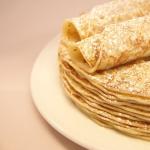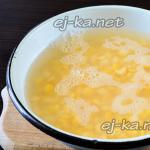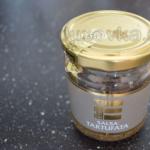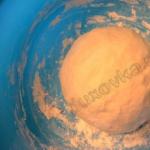Buckwheat with milk: calorie content, benefits, nutritional value. Why buckwheat porridge is considered the best porridge for weight loss
Along with oatmeal and rice, buckwheat porridge is one of the three most commonly consumed and healthy porridges. Due to its wide range of healing properties, it is used in children's, dietary, and medical nutrition. And given the ease of preparation, compatibility with many other food groups and the pleasant taste of buckwheat porridge, the demand for it is unlikely to fall in the coming years. This dish can help out when you don’t have enough time, when you suddenly feel sick to your stomach, and even if you need to add something to meat or fish. Buckwheat porridge can be used to create a hearty and tasty lunch or dinner without much effort. And it is precisely this popularity that makes everyone who watches their diet interested in how many calories are in buckwheat porridge, cooked in various ways. Is there any particularly useful or, on the contrary, unnecessarily harmful option, what is the difference between cooked and steamed buckwheat porridge, and also whether it can be eaten frequently.
How many calories are in buckwheat porridge?
Any buckwheat porridge - with milk, water, or even meat or vegetable broth - starts with dry cereal, which is carefully sorted, cleaned of impurities, washed to get rid of dust and sand, and only then poured into boiling liquid. The “weight” of the dry product should not be scary - these 308 kcal per hundred grams will not be transferred entirely into the calorie content of buckwheat porridge, since during the cooking process the cereal swells, absorbing moisture, and increases in volume. As a result, from one hundred grams of dry buckwheat you get almost three hundred and twenty ready-made buckwheat porridge, the calorie content of which will range from 87 to 120 kcal per hundred grams. The figure varies depending on how soft the finished dish is and whether it has any other additives in the form of sugar or butter. The simplest, barely salted buckwheat, boiled to the point where there is practically no need to chew it, will weigh only 87-90 kcal. But the calorie content for buckwheat porridge in water, which remains crumbly and more like a cereal side dish, will already be 118-120 kcal per hundred grams, because it will absorb significantly less water, which will mostly evaporate during the cooking process, and therefore its volume will not increase so significantly, and calorie content will not drop much. This buckwheat porridge is mainly used for fasting days and simply in the process of losing weight. No butter, sugar, or other sauces or seasonings other than salt are added there. This is the most useful, although also the most empty and, for some, tasteless, version of buckwheat porridge, which allows you to get most of the vitamins and microelements included in its chemical composition. Buckwheat porridge made with milk is not so much higher in calorie content than the previous version. It contains 87 kcal when using store-bought milk with a fat content of 3.2%, if you do not add anything other than salt to it, and almost 136 kcal if you cook it with milk from your own cow, and even flavor it with butter. But what absolutely cannot be ignored is the fact that even if the calorie content of buckwheat porridge with milk increases when using natural cow’s milk, such a union is one of the best sources of protein, especially for those who, for certain reasons, do not consume meat products .
As for its effect on the body, buckwheat porridge has a truly great track record. First of all, it is worth noting its beneficial effects on the gastrointestinal tract. For all its satiety, obtained due to the high fiber content, it does not carry a high burden on digestion: with the usual portion of buckwheat porridge required for saturation, a feeling of heaviness will not appear. A similar effect is achieved due to the presence of pectin in the chemical composition of buckwheat, which helps normalize the functioning of the gastrointestinal tract, cleanse toxins and improve intestinal microflora. For this reason, by the way, unlike many other cereals, without wondering how many calories are in buckwheat porridge, you can eat it for dinner and even in small quantities after it, if you are overtaken by an acute feeling of hunger, and there is still an hour and a half before bed -two. It will not require increased work of the body, which should already be preparing for a night's rest, and therefore will not disrupt metabolism and will not affect body weight. And the lecithin contained in it, instead of putting a strain on the pancreas, on the contrary, will provide it with support.
Secondly, buckwheat porridge is incredibly useful for problems with blood vessels and hematopoiesis. The presence of iron and copper in it affects hemoglobin and the synthesis of blood cells, and rutin - vitamin P - strengthens the walls of blood vessels and increases the rate of blood clotting, which is especially appreciated during bleeding, both internal and external. You can increase these indicators by combining buckwheat porridge with chicken or beef liver. In tandem with ascorbic acid, rutin affects the thyroid gland, with potassium and magnesium - on the heart muscle, and also reduces blood pressure, normalizes blood sugar levels, and alleviates the condition of pregnant women during toxicosis. And among other things, the rich chemical composition of buckwheat porridge actively supports the immune system, putting its protective functions on alert.
Buckwheat porridge in the diet of those who watch their figure
 Those who want to get rid of deposits in the hips and abdomen are strongly recommended to try a diet based on buckwheat porridge, which is cooked in a special way. To be more precise, it is not boiled, but steamed for eight to ten hours, and therefore they leave it overnight. The cereal is poured with boiling water, wrapped in a towel and left to brew in a warm place. In this case, the calorie content of buckwheat porridge on water does not change compared to the usual version, but it does not have salt, which means it does not interfere with the removal of excess fluid from the body. And, in addition, unlike cooked buckwheat, steamed buckwheat retains absolutely all the beneficial substances: in general, during the cooking process, cereals lose some of their vitamins and microelements, as if “weakening” in terms of healing. That is why all porridges are advised to either steam or cook for a short period of time.
Those who want to get rid of deposits in the hips and abdomen are strongly recommended to try a diet based on buckwheat porridge, which is cooked in a special way. To be more precise, it is not boiled, but steamed for eight to ten hours, and therefore they leave it overnight. The cereal is poured with boiling water, wrapped in a towel and left to brew in a warm place. In this case, the calorie content of buckwheat porridge on water does not change compared to the usual version, but it does not have salt, which means it does not interfere with the removal of excess fluid from the body. And, in addition, unlike cooked buckwheat, steamed buckwheat retains absolutely all the beneficial substances: in general, during the cooking process, cereals lose some of their vitamins and microelements, as if “weakening” in terms of healing. That is why all porridges are advised to either steam or cook for a short period of time.
For ordinary dietary nutrition, of course, it is permissible to prepare any buckwheat porridge: the calorie content allows you to add butter and sugar to it, and even mix in vegetables, fish or meat, sprinkle with cheese, choose any base for cooking - milk, water or meat broth. There is probably no more ideal product among cereals for those who want to lose weight or maintain existing results regarding their figure. This can be seen even from the caloric content of buckwheat porridge. A variation with tender white chicken meat, carrots, sweet red peppers, onions, tomatoes, herbs, garlic, seasonings and a spoon of olive oil in a slow cooker will be only 103 kcal per hundred grams of product. Moreover, this dish can be considered a complete hearty lunch for an adult not only due to cereals and vegetables, but also due to the presence of meat. In addition, it has an almost perfect balance of proteins, fats and carbohydrates, since absolutely everything is present and in the right combination. Even olive oil acts not just as an ingredient that eliminates the dryness of the dish, but also for the purpose of better absorption of vitamin A from carrots, which always requires fat: butter or sour cream.
4.9 out of 5 (7 Votes)
Buckwheat is an indispensable product for any diet. It contains a lot of useful substances (vitamins, minerals) that are beneficial to the human body: polyunsaturated fatty acids reduce the amount of cholesterol and sugar in the body, and also contains vitamins B and P, potassium, iodine, removes toxins, improves digestion, is useful for fatigue, depression.
Buckwheat is the most popular in our country for its unique properties. This cereal can be prepared in a variety of ways, as an independent dish, and as part of other dishes, including served with milk. It has excellent taste and many positive properties. It is included in the diet of adherents of a vegetarian lifestyle, as it has a rich chemical composition and can serve as an excellent replacement for some protein dishes of animal origin.
Benefit
It is worth noting that the cereal is saturated with micro and macroelements such as manganese, calcium, chromium, iron, phosphorus, copper. The composition also contains chlorine, cobalt, fluorine, zinc, selenium and boron in small quantities. The vitamin composition is represented by group B, A, PP, E. In addition, cereals are rich in amino acids, which the body needs to build muscle fiber. Folic acid, also present in buckwheat, is beneficial for pregnant women. Another component, lysine, has strong antiviral properties. Cereals also contain a lot of fiber, which helps improve digestion and normalize intestinal function. When eating cereal, a person forgets about a bad mood, feels cheerful, and gains new strength.
The second component of the dish, milk, also has a rich composition. It contains many minerals, vitamins, fatty acids, globulin, lactose. Its use helps improve the functioning of the digestive system and strengthen the body's defenses. The product will also be useful if gastric juice has high acidity. It is not recommended to include milk in the diet of persons with lactose intolerance. Use should also be limited to older people, as the product contains a component that stimulates the development of atherosclerosis. Some people may also be allergic to the product.
Buckwheat with milk is an excellent option for those who want to lose weight, as the food is rich in healthy compounds and contains few calories. The dish is very rich in essential elements, it contains a lot of proteins and fiber, but few harmful fats. Therefore, if there are no contraindications, you can eat it every day in reasonable quantities.
For those losing weight
Despite the fact that the calorie content of buckwheat with milk is quite high, it is recommended to include it in the diet when losing weight. The thing is that porridge improves metabolism and promotes rapid saturation. So, if you cook cereal in water and pour milk over it, then the calorie content of boiled buckwheat with milk and sugar per 100 g of product will be about 200 kcal.
The nutritional value
100 g of dish contains:
- calories - 155 kcal
- fats - 2.0 g
- carbohydrates - 27 g
- proteins - 7 g
If you add butter to the porridge, the nutritional value of the dish will increase to 300 kcal. Therefore, if you want to lose a little weight, then it is best to steam the cereal with boiling water, and then pour it with low-fat milk without adding butter and sugar. In this case 1 serving of this dish has a calorie content of 90-120 kcal(depending on the fat content of the milk).
The meal is an excellent solution not only for those who are losing weight, but also for everyone who strives to maintain a high level of their health. Porridge is completely absorbed by the body, so you should not be afraid that calories will be deposited somewhere. Such a breakfast will completely saturate the body and provide enough energy.
Buckwheat porridge with milk rich in vitamins and minerals such as: vitamin B1 - 28.7%, vitamin B2 - 11.1%, vitamin B6 - 20%, vitamin PP - 36%, potassium - 15.2%, silicon - 270%, magnesium - 50%, phosphorus - 37.3%, iron - 37.2%, cobalt - 31%, manganese - 78%, copper - 64%, molybdenum - 49.1%, selenium - 15.1%, zinc - 17, 1 %
Benefits of buckwheat porridge with milk
- Vitamin B1 is part of the most important enzymes of carbohydrate and energy metabolism, providing the body with energy and plastic substances, as well as the metabolism of branched amino acids. A lack of this vitamin leads to serious disorders of the nervous, digestive and cardiovascular systems.
- Vitamin B2 participates in redox reactions, helps to increase the color sensitivity of the visual analyzer and dark adaptation. Insufficient intake of vitamin B2 is accompanied by impaired condition of the skin, mucous membranes, and impaired light and twilight vision.
- Vitamin B6 participates in maintaining the immune response, processes of inhibition and excitation in the central nervous system, in the transformation of amino acids, the metabolism of tryptophan, lipids and nucleic acids, promotes the normal formation of red blood cells, maintaining normal levels of homocysteine in the blood. Insufficient intake of vitamin B6 is accompanied by decreased appetite, impaired skin condition, and the development of homocysteinemia and anemia.
- Vitamin PP participates in redox reactions of energy metabolism. Insufficient vitamin intake is accompanied by disruption of the normal condition of the skin, gastrointestinal tract and nervous system.
- Potassium is the main intracellular ion that takes part in the regulation of water, acid and electrolyte balance, participates in the processes of conducting nerve impulses and regulating pressure.
- Silicon is included as a structural component in glycosaminoglycans and stimulates collagen synthesis.
- Magnesium participates in energy metabolism, synthesis of proteins, nucleic acids, has a stabilizing effect on membranes, and is necessary to maintain homeostasis of calcium, potassium and sodium. A lack of magnesium leads to hypomagnesemia, an increased risk of developing hypertension and heart disease.
- Phosphorus takes part in many physiological processes, including energy metabolism, regulates acid-base balance, is part of phospholipids, nucleotides and nucleic acids, and is necessary for the mineralization of bones and teeth. Deficiency leads to anorexia, anemia, and rickets.
- Iron is part of proteins of various functions, including enzymes. Participates in the transport of electrons and oxygen, ensures the occurrence of redox reactions and activation of peroxidation. Insufficient consumption leads to hypochromic anemia, myoglobin deficiency atony of skeletal muscles, increased fatigue, myocardiopathy, and atrophic gastritis.
- Cobalt is part of vitamin B12. Activates enzymes of fatty acid metabolism and folic acid metabolism.
- Manganese participates in the formation of bone and connective tissue, is part of enzymes involved in the metabolism of amino acids, carbohydrates, catecholamines; necessary for the synthesis of cholesterol and nucleotides. Insufficient consumption is accompanied by slower growth, disturbances in the reproductive system, increased fragility of bone tissue, and disturbances in carbohydrate and lipid metabolism.
- Copper is part of enzymes that have redox activity and are involved in iron metabolism, stimulates the absorption of proteins and carbohydrates. Participates in the processes of providing oxygen to the tissues of the human body. Deficiency is manifested by disturbances in the formation of the cardiovascular system and skeleton, and the development of connective tissue dysplasia.
- Molybdenum is a cofactor for many enzymes that ensure the metabolism of sulfur-containing amino acids, purines and pyrimidines.
- Selenium- an essential element of the antioxidant defense system of the human body, has an immunomodulatory effect, participates in the regulation of the action of thyroid hormones. Deficiency leads to Kashin-Beck disease (osteoarthritis with multiple deformities of the joints, spine and limbs), Keshan disease (endemic myocardiopathy), and hereditary thrombasthenia.
- Zinc is part of more than 300 enzymes, participates in the processes of synthesis and breakdown of carbohydrates, proteins, fats, nucleic acids and in the regulation of the expression of a number of genes. Insufficient consumption leads to anemia, secondary immunodeficiency, liver cirrhosis, sexual dysfunction, and the presence of fetal malformations. Research in recent years has revealed the ability of high doses of zinc to disrupt the absorption of copper and thereby contribute to the development of anemia.
You can see a complete guide to the most useful products in the appendix.
Buckwheat porridge has a rich vitamin and mineral composition. It is rich in fiber, vitamins B1, B5, B6, H, PP, E, minerals manganese, potassium, magnesium, copper, selenium, zinc, sodium, iron, boron, iodine.
The calorie content of buckwheat porridge with water and butter per 100 grams is 120.2 kcal. 100 g of this dish contains:
- 2.52 g protein;
- 4.87 g fat;
- 17.6 g carbohydrates.
To prepare buckwheat porridge with water and butter you need:
- Rinse 150 g of buckwheat, pour into a saucepan and add water;
- cook the porridge until it becomes viscous;
- add 12 g of butter and 12 g of sugar to boiled buckwheat;
- let the porridge brew for 5 minutes.
The calorie content of buckwheat porridge in water without oil per 100 grams is 102 kcal. In 100 g of dish:
- 4.23 g protein;
- 1.07 g fat;
- 20.1 g carbohydrates.
Porridge recipe:
- Rinse 200 g of buckwheat and add 400 g of water;
- add 2 g salt;
- cook the porridge after boiling over low heat for 15 - 20 minutes;
- Add greens to the finished porridge.
Calorie content of buckwheat porridge with milk per 100 grams
The calorie content of boiled buckwheat porridge with milk per 100 grams is 118.2 kcal. Per 100 gram serving:
- 4.21 g protein;
- 2.29 g fat;
- 21.61 g carbohydrates.
Buckwheat with milk is saturated with pectin, lecithin, vitamins B, PP, H, E, minerals magnesium, potassium, manganese, copper, zinc, calcium, selenium, iron, phosphorus, sodium.
Recipe for making buckwheat porridge with milk:
- pour a glass of buckwheat into a saucepan;
- pour a glass of boiling water into the porridge;
- cook the porridge over low heat for 5 minutes;
- then add 1 glass of milk;
- cook buckwheat covered for 12 minutes;
- add sugar and salt to the porridge to taste;
- let the boiled buckwheat brew under the lid for 10 - 20 minutes.
The benefits of buckwheat porridge
The benefits of buckwheat porridge are quite large and are as follows:
- The product is rich in rutin, which is necessary to strengthen the walls of blood vessels. It is thanks to the routine that buckwheat porridge is necessarily included in the diet for varicose veins, hypertension, rheumatism;
- Buckwheat lecithin helps restore the membranes of brain and nervous system cells;
- Buckwheat iron is necessary to reduce hemoglobin levels in the blood;
- buckwheat flavonoids ensure longevity, maintain youthful skin, nails, and hair;
- magnesium in porridge is necessary to maintain the health of the nervous system, heart and blood vessels;
- Buckwheat is rich in folic acid, which reduces the risk of developing cancer and is essential during pregnancy.
Harm of buckwheat porridge
Buckwheat porridge should be avoided if:
- individual intolerance to the product;
- development of allergic reactions to buckwheat, including those manifested in the form of rashes, itching, peeling of the skin;
- in case of violation of the shelf life of porridge. In this case, mold quickly forms on the cereal, the entry of which into the body can cause serious poisoning.
During pregnancy, you should not overeat buckwheat, as due to the sufficiently large amount of protein, porridge can cause stomach and intestinal disorders.
Among dietary foods, buckwheat takes pride of place. Representing not a grain, as many mistakenly believe, but a cereal, it was imported from Greece.
What makes buckwheat healthy is its composition. Cereals contain a high concentration of polyunsaturated fatty acids. They help reduce bad cholesterol and have a positive effect on the metabolic process. Thanks to the latter quality, a person who eats buckwheat loses weight faster, despite the fact that it is high in calories.
This cereal contains many flavonoids, which prevent the growth of cancer tumors and prevent the risk of thrombosis. Buckwheat normalizes blood sugar and is recommended for inclusion in the diet of diabetics. The folic acid present in the product makes it valuable for women during pregnancy.

The energy value of dry buckwheat is 370 calories, and boiled buckwheat, including the water absorbed during cooking, is 150 calories for every 100 g of product. Carbohydrates account for 29, proteins - 5.9, and for fats - 1.6 g.
How many calories are in buckwheat with water?

Cereals cooked in water turn out to be quite liquid and low in calories. The calorie content of the dish is approximately 90 kcal. It contains vitamins and minerals. Adding meat and other ingredients to such porridge will significantly increase the calorie content.
If you add salt and oil to buckwheat in water, its calorie content will increase almost to 500 calories per 100 grams! Heat treatment does not affect the number of calories in porridge.
Eating buckwheat porridge with water during a diet provides the body with oxalic acid, calcium, iodine, iron, amino acids, phosphorus, and vitamins from groups B and PP. It contains folic acid, which strengthens the heart muscle and blood vessels. The product has an excellent taste, which makes boiled porridge an excellent choice for both dietary and health-improving menus.
Calorie content of buckwheat with milk
To prepare milk buckwheat dietary porridge, you should use only low-fat whole milk. It is important for those losing weight to constantly count calories.
When including buckwheat porridge with milk in the diet menu, it should be taken into account that the energy value of both products is summed up together. For 100 grams of cereal take 50 ml of milk, which gives about 200 calories.
Porridge has no restrictions. You can eat the dish at any time of the day. It improves metabolism and provides the body with protein (protein). The presence of fiber helps cleanse and get rid of slagging.






